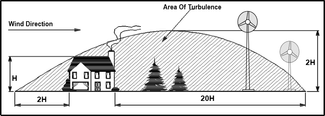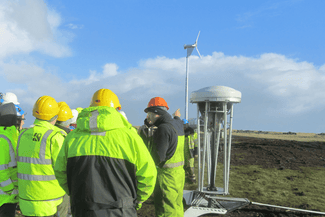
The wind is a by-product of uneven heating of the Earth's atmosphere by the sun, and has a very complex distribution pattern. Though widely spread, winds are most prevalent along coasts, at higher elevations and at higher latitudes.
Power in wind = ½ x Air Density x Swept Area x Windspeed³
The power in the wind is proportional to the cube of its speed - twice the wind speed gives eight times the power.
- Small differences in average windspeed cause large differences in available wind energy. So, for optimum performance, it is important to find a site which offers the highest overall windspeeds.


Wind speed can increase dramatically with height
This is especially the case over rough surfaces, such as in wooded or hilly areas.
- This means a significant increase in power production can often be obtained for a given cost by using a smaller wind turbine on a taller tower rather than simply using a larger machine.
The wind energy that a wind turbine can potentially capture is related to rotor swept area and consequently rotor diameter

The area swept by a wind turbine's rotor determines how much wind can be captured. Twice the rotor radius/diameter give four times the area.
- A 41% increase in radius/diameter results in a doubling of swept area, and thus twice as much energy potential.
This means rotor diameter is really a better measure of a wind turbines potential production rather than some manufacturer kW rating.


Compare wind turbines by comparing their power curves

The power curve shows how expected output can vary Wind Power Curve according to windspeed and shows at what windspeed power is limited to protect the turbine from extreme conditions. Performance in typical lower average windspeeds is more important than 'peak' performance.
Power curves are provided by manufacturers. Those based on measured data collected over long periods of time in real wind conditions are much more meaningful than those produced theoretically.


Wind turbines need to be in the wind!
Siting of a wind turbine should take account of exposure to the prevailing winds. Avoid locations with excessive gustiness or turbulence, since they will reduce the output from a wind turbine and lead to undue wear and strain on component parts.
- Factors such as surface roughness and obstructions are important, e.g. woodland or built up areas will create higher turbulence than open grassland. Cliff tops are to be avoided and wind generators must be sited clear of obstructions to the wind.
- A useful rule is to place the wind turbine at a distance from any obstacle (building etc.) of at least ten times the height of the obstacle; or on a tower that is at least twice that height.
- The ideal site for a wind turbine is a smooth hill top, with a flat, clear fetch at least in the prevailing wind direction.
- Near the top of the hill the wind speeds up significantly and the flow should be reasonably smooth.
Mounting wind turbines on buildings is nearly always disappointing apart from small machines used for example to provide remote building lighting. Structural issues and transmitted noise need to be considered and winds around buildings are very turbulent. Maintenance can also be difficult.
In choosing a good site for a wind turbine there really is no alternative than having a site survey by an experienced installer.


How Windy Is It?
1 m/s = 2.24 mph ; 1 mph = 0.45 m/s ; 1 knot = 0.51 m/s (1.15 mph)


Wind turbines will require maintenance

Wind turbines comprise moving parts and involve long hours of operation sometimes under extreme conditions. To minimise wear and tear they incorporate a governing system to control overspeed and provide high windspeed protection.
However, periodic inspection and maintenance will be required which means that turbines will need to be lowered to the ground.



